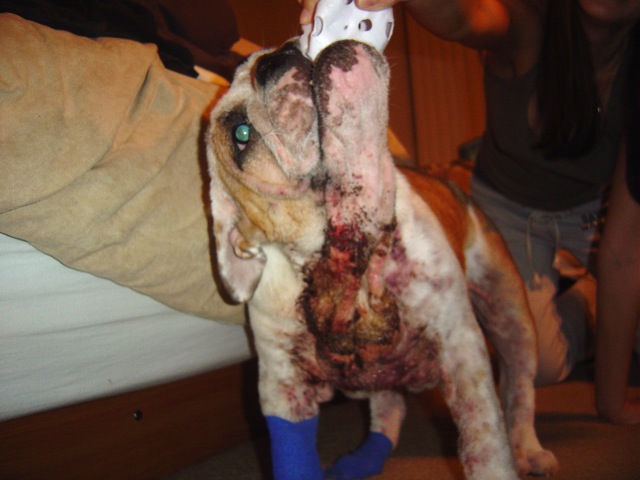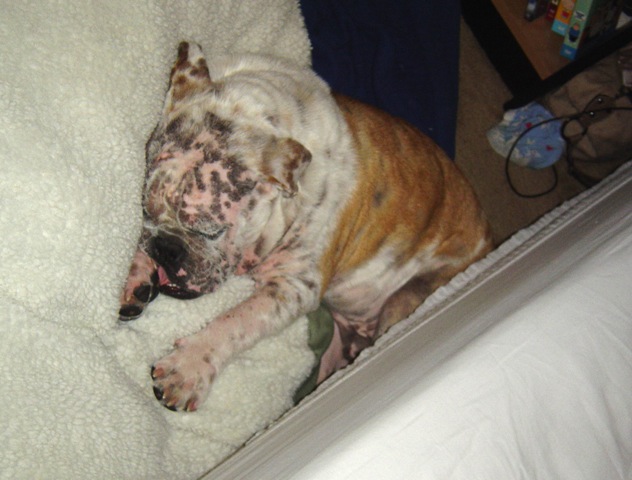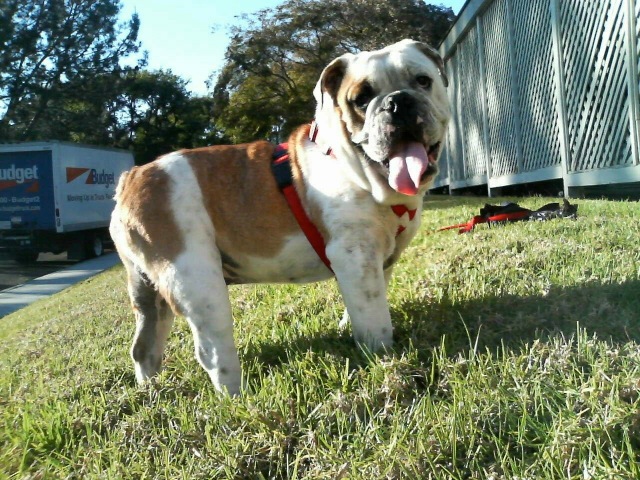THE VET can be your BULLDOG & your WALLETS worst nightmare?
What I am about to write is merely my opinion. However these opinions were derived based on factual occurrences that I have been privy to in my many years as a lover and breeder of the mighty BULLDOG.
After carefully researching Bulldogs, you must conclude that they are high maintenance, high price and highly esteemed as a wonderful part of any family. From the beginning, Bulldogs must be artificially inseminated, C-Sectioned and the moms can and will accidentally crush and kill the babies in the first few weeks unless around the clock supervision is not maintained. Often times we must take the pups away from mom completely in the first few days and raise them ourselves. To successfully raise a litter of Bulldog pups to 8 weeks old is a miracle in itself.
Here is how it works. Bully goes to his new home. Ahhhh sooooo cute. Then Bully goes to get puppy wellness physical. Vet usually assures the new owner that he/ she has lots of experience with Bulldogs and scares them to death by parroting back what they were taught in vet school about Bully. However in The Vets defense, a person only knows what they have been taught or have experienced. Many of these Vets are very nice wonderful people that I would happily to go out and eat with. But just because a Vet has a good bedside manner, does not mean that they are competent. Most simply lack the experience.
Below are a few short versions to long stories, but after reading you will get the idea. I have literally 100 or more stories, but these are a few good ones.
REAL STORY: A customer once called and told me that I would be happy to know that her Vet was quite experienced with Bulldogs. When I asked what the Vets credentials were, she exclaimed that her Vet attended the University of Georgia and she was the primary Veterinarian caretaker for Uga the schools Mascott….
Are you kidding. One Bulldog and she is experienced. You’ve go to be joking. My Vet see’s approx. 50 + – Bulldogs per day and performs almost any general and sometimes special surgery that a Bulldog necessitates. That is what I consider experience.
REAL STORY: This exact story happened 3 times last year. All were separate occurrences, took place in different cities and obviously with different Vets.
Symptoms: Bully has a green snotty nose and becomes lethargic. Customer calls me frantic from the Vets office stating that their Vet told them that they must return the Bulldog immediately to the breeder because it had Distemper. All three times I spoke the Vet on the telephone in the presence of the customer and told them that the dog had a simple upper respiratory infection that needed to be treated with antibiotics and so forth. Neither of the 3 Vets would concede so I made each of them this wager. I told them that if the dog has Distemper then I would give him $10,000 cash and if it does not he waives the Vet fee for the customer.
What do you think happened? Yeah you got it. I still have my 10 Grand and the customer paid the bill. On all 3 occurrences, I picked up the dog from the customer, treated it and returned it 5-7 days later completely well. (By the way Distemper is usually a death sentence for any pup that contracts it and if a pup has it then all of the siblings will have it as well. Distemper is also extremely rare these days..)
REAL STORY: My good friend and partner breeder told me this story several years ago. Bully was approx. 12 weeks old and the front right leg near the paw was becoming twisted and the dog began to hobble. Customer did not call him first, she took Bully to The Vet. This Vet from UC Davis (A very prominant Vet School) sent her to a Specialist (I cringe when I hear that word SPECIALIST) My experience has been that many Specialist specialize in taking your money. Anyhow the Specialist concluded that Bully had a genetic birth defect that caused one bone to be longer than the other in the lower leg. Prognosis, break the shorter bone and put a pin in it. Price tag $3300. Luckily after scheduling the procedure, the lady called my partner to convey the information. Long story short, he told her The Vet was smoking crack and to leave the leg alone and it would straighten out in a month or so. What do you think happened? Yeah you got it. No surgery and a perfectly formed Bully Leg. Cost of the tests…..$800 bucks.
REAL STORY: My good friends Mom purchases pup. Pup was totally healthy for several years then one day becomes lethargic and throwing up. Mom who loves the Dog more than herself, hurries over to a well known Veterinarian Specialist Hospital located in Escondido California. After several days my friend called to ask my opinion because they had performed test after test to no avail. I told him to get the dog and go to see Dirk Butchko. What do you think happened? He did not heed my warning but finally removed the dog from the hosapital after 8 days. The dog was no better than when he first went in. He took the dog home it went outside and ate some grass and has been 100% ever since. Price tag $9800. I know this for sure because I have a copy of the bill.
As the owner of a Bully, it is most important to choose your Bulldogs Vet most carefully. Here is a checklist that may help when you are choosing your Bully’s Vet.
The BIGBULLDOGS WARNS you to choose your Vet carefully. Most all Vets will tell you that they are experienced with Bulldogs but sadly some of these poor Bulldogs have found this to be far from the truth.
1. Most importantly, ask the Vet what they use to sedate a Bulldog. If it is anything other than Propofol with
Iso Fluorine gas and full intubation, MOVE ON. (English Bulldogs and French Bulldogs are different than other dogs when it comes to anesthetizing. Many Bulldogs die unnecessarily each year while under Anesthetic for simple procedures.) It is your responsibility to be certain that your Vet is qualified in the Bulldog arena.
2. Ask how many Bulldogs does the Vet anesthetize weekly. If it is less than 10, MOVE ON.
3. Does the Vet do his or her own surgeries for the following; Cherry Eye, Bladdar Stones, Elongated Soft Pallet, Hernias (Inguinal & Umbilical), C-Sections, Progesterone Tests, Basic Knee Surgeries. These are just a few, but if he does not do the basics, then MOVE ON.
4. Does the Vet read and interpret his/ her own X-Rays or do they send them out to a Radiologist. If they cannot read and accurately interpret their own X-Rays, MOVE ON.
5. Does the facility appear clean and sanitary? If not MOVE ON.
I will continue to update these stories when I have time to do so. Once again they are not meant to bash Vets or imply anything other than to give you information on my experiences so that you may have adequate ammunition when choosing the right vet for your Bully. Remember The VET can be your Bulldogs best friend or worst nightmare.


